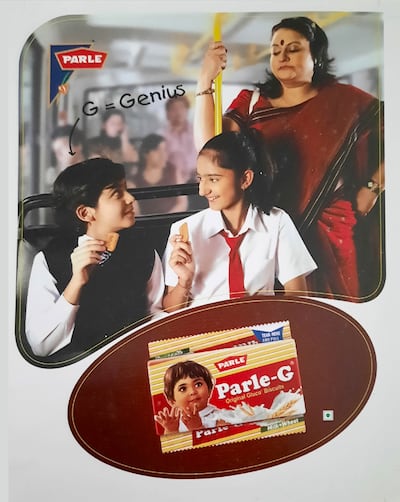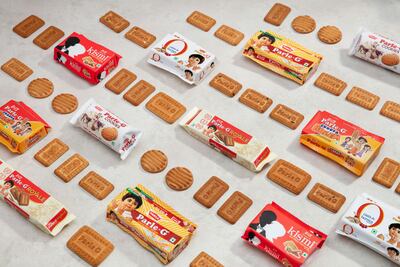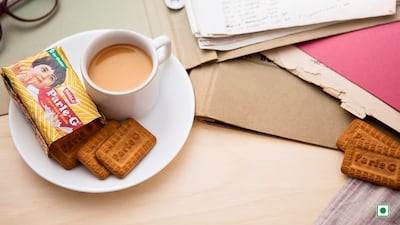If you’re Indian, there's a good chance you've eaten a Parle-G biscuit.
Eighty-four years after the first “gluco biscuit” was baked, the mildly sweet, malty and crisp treat remains a harbinger of nostalgia for anyone who grew up in an Indian household.
Kurush Dalal, a culinary anthropologist and entrepreneur from Mumbai, says Parle-G is the “taste of childhood” for most Indians.
The biscuit is omnipresent and all-pervading in the country. You can find it in roadside stalls shops and large supermarkets, in villages, towns and metros. The dependable staple – which ranks among the world’s top-selling biscuits – is a unique equaliser.
“From the 1970s to children today, breaking open a packet is a continued tradition across the classes and masses,” says Dalal.
senior category head, Parle Products
Over the years, the biscuit has become a part of India's cultural consciousness, with the brand becoming a cultural and nostalgic touchpoint for generations of Indians, including the diaspora.
The House of Parle, which now offers a range of baked products, confectionery, cakes, rusks and snacks, had humble beginnings. It was launched in 1929 by Mohanlal Dayal Chauhan. The first factory, which employed 12 people, focused on confectionery. In 1938, the company baked its first biscuit: Parle Gluco.
Taste of patriotism
The company traces its roots to Swadeshi (self-sufficiency) ideals. The Indian independence movement, based on Mahatma Gandhi’s non-cooperation philosophy, relied on a shift to only Indian-made goods as a form of civil disobedience, and Chauhan decided to do his bit.
Mayank Shah, senior category head at Parle Products, says a trip to Europe led the founder to discover that the biscuit-eating culture was prevalent in most homes. “In India, biscuits were seen as elitist and consumed only in upper-class homes,” says Shah. “He decided to pivot and ensure that every Indian could afford a biscuit, and so he launched a brand that was accessible to everyone.”
Chauhan’s venture meant Indians no longer relied on imported products – especially British-made biscuits that were expensive and solely the preserve of the wealthy.
In 1947, after India gained independence, Parle launched an advertisement campaign, offering its Gluco biscuits as an Indian alternative to British brands.
Taste of success

A packet of Parle-G – easily identified by its yellow-striped packaging and baby mascot – offers no fripperies. There is no cream, chocolate or dried fruit to be found here. The rectangular biscuit merely has its name stamped in the centre and is surrounded by an ornamental border.
The manufacturing process, too, has remained consistent over the decades. A specific mix of wheat flour, milk powder, sugar, salt, palm oil, preservatives and flavouring is baked at up to 280°C for eight minutes.
Parle-G created the biscuit-eating culture in India, according to Shah, who says biscuits and baking weren’t traditionally part of the nation's culinary history.
Called Parle Gluco until 1985, the brand rebranded its biscuits to Parle-G in the mid-1980s. The “G” originally stood for “glucose”, but a later campaign referred to it as “G for genius”. In the late 1990s, a marketing campaign with Indian superhero Shaktimaan lifted sales from 50 tonnes to 2,000 tonnes a month.
In 2011, a Nielsen survey stated that Parle-G was one of the best-selling biscuit brands in the world. In 2013, it became India’s first fast-moving consumer goods brand to cross the Rs5,000 ($600 million) crore mark in retail sales.
Parle’s flagship factory in Vile Parle, a Mumbai suburb the company derived its name from, shut down in 2016, but many consumers still recall the aroma of freshly baked biscuits that filled the air when passing through the area.
Taste of familiarity

The pandemic turned things around for Parle-G.
In a time of uncertainty and insecurity, people wanted to cling to the familiar. At stores and supermarkets, there was a run on the biscuits. Government and non-government agencies chose Parle-G for food relief packages, which helped the brand register phenomenal growth.
“We saw one of the highest growth spurts in recent times; we haven’t seen anything like it,” said Shah, adding that the fact that “people trusted the brand and it had a long shelf life” aided sales.
Parle increased its market share by 5 per cent during the lockdown. Even as packets flew off the shelves, the company distributed 30 million packets to migrants returning home after India tightened its borders in response to Covid-19. The gesture created immense goodwill.
“We always said Parle-G was 'Bharat ka apna biscuit' [India’s own biscuit], and now people played it back. It generated immense love and resonated across strata,” Shah says.
The Parle-G brand is now valued at Rs5,000 crore. It has 120 factories in India, where 400 million biscuits are baked every day. About one billion packs of Parle-G are produced monthly, with as many as 4,551 Parle-G biscuits consumed per second, estimates Shah. The biscuit is also exported to 100 countries, including the UAE.
Ajay Chauhan, the company’s executive director, says the brand has grown so big that “most people know the company as Parle-G”.
The pricing and strong distribution network have ensured affordability and availability for everyone. The biscuits, stocked at seven million outlets in India, are available in multiple packs priced from a mere Rs2 ($0.02).
Dalal attributes the brand’s success to the fact that the company came up with a product that tapped into what many people look for when making a purchase: value for money.
“The fact that the biscuits were available even in very small sizes meant that they were easy to put into handbags, tiffins and dabbas. The price meant they equalised the market between the rich and poor,” he says.
Various flavours and recipe twists
Over the years, Parle introduced a variety of offerings: biscuits such as Monaco, Krackjack and Cheeselings; confectionery such as Kismi, Poppins and Melody; and a premium range called Platina that offers Hide & Seek, Milano and Nutricrunch. However, it is the original Parle-G, rather than recent variants such as oats and berries or cinnamon, that remains its flagship flavour.
The pantry staple is now being used in different ways. Chefs and home cooks are experimenting with Parle-G and high-end restaurants are incorporating it into desserts and milkshakes. Parle-G even found its way on to a lunch menu at the White House during Indian Prime Minister Narendra Modi's recent visit to the US. The biscuits were used to create the base for a mango halwa.
Meanwhile, the internet offers hundreds of recipes to make Parle-G desserts such as cookie butter, Swiss rolls, pies, tiramisu, panna cotta and ice cream sandwiches.
Chef and author Anahita Dhondy says the biscuit has “an extremely versatile nature”, which lends itself to being used in multiple ways in the kitchen. Her favourite? A Parle-G and mango cheesecake that combines two favourite Indian tastes.
As Shah puts it: “Parle G does not belong to us; it's owned by consumers, each of whom has their own story and memory associated with the biscuit.”

